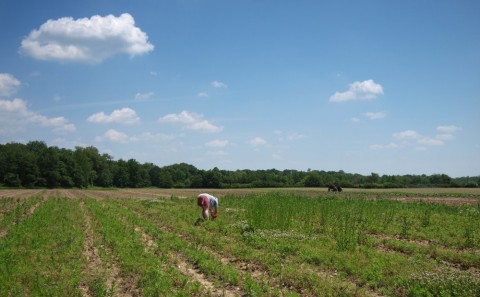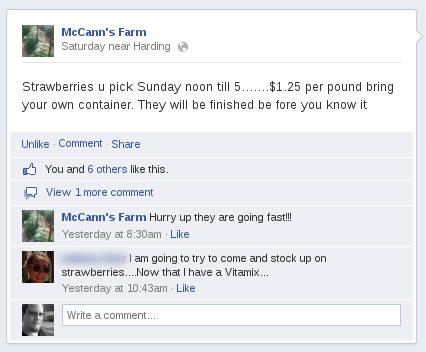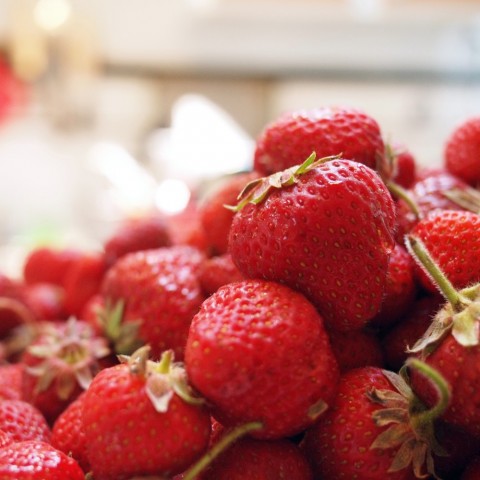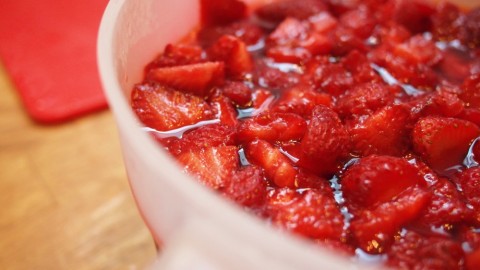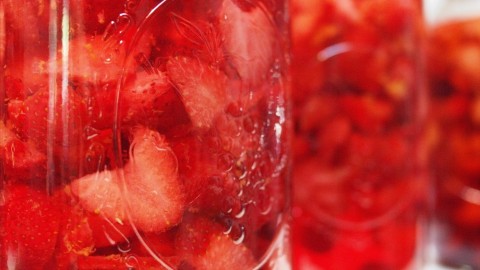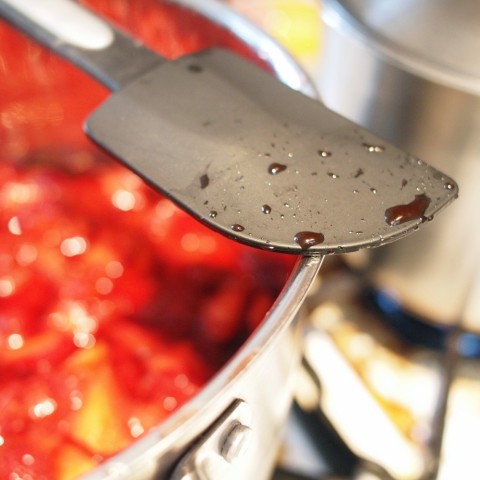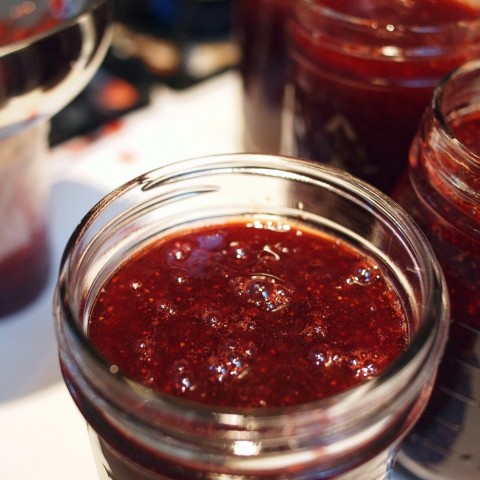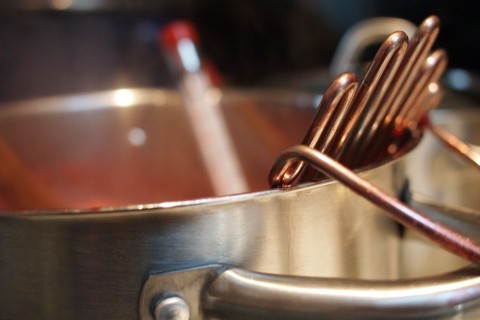Here are some helpful rules for heading out to a local farm to pick your own produce:
- Always wear sunscreen. And don’t forget dabs for your neck, ears, and the small of your back (plumbers out there, you know what I’m talking about).
- Drink lots of water, and take lots of breaks. Fruit season is hot here in the mid-Atlantic, and you wouldn’t want to overdo it.
- Don’t pick more than you need. Call this the ‘save some for the fishes’ rule, if you want. The point is that the next group might want some berries / peaches / asparagus, too.
- And above all, be nice to the plants.
I say ‘above all’ to that last point because — phew boy do I have a story for you. Last week, as I was you-picking out in New Jersey at the McCann’s Farm, intrepid agriculturalist and friend of the blog Anita had this to say:
It seems that a couple of summers back, a fellow came by to pick his own fruit and discovered a field of hot peppers. Can I pick some of those, too? he asked. Sure, Anita responded, and went back to her business, paying him no mind at all.
Sometime later, a call comes in from the kids, who were out working in an adjacent field: Mom, come quick! Somebody’s got into the peppers.
I know. I told him he could pick there.
No. You don’t understand. He’s tearing them all out!
This fellow, it turns out, had decided for whatever reason that bending over to pick peppers wasn’t for him. Maybe his legs were sore, or maybe he had some kind of condition. Maybe he had neglected to sunscreen the small of his back. I don’t know. But whatever the cause, his method for ‘picking peppers’ was to pluck the poor plant out of the ground by its roots, pull off its spicy fruits, and discard the abused remains somewhere between the rows.
Apparently, he had gone through a dozen plants at least before they caught him. And he would have kept at it had it not been for the call.
So what I’m saying folks, is that when a farmer offers to let you pick your own — when a farmer posts a notice on Facebook like this:
Don’t be that guy. Vegetable farmers make a living by the bounty that their plants produce, and continue producing, over the course of the whole growing season. Mess with the plants and you mess with the farmers. And that’s good for exactly no one.
In the meantime, I’d like to think that when Linda and I went to pick our batch of strawberries, we were particularly good pick-your-own citizens. I’d like to think that we were kind to the plants (though really, it’s hard to hurt a strawberry patch). And as per rule number three: though I ended up with ten pounds of fruit myself, and though Linda ended up with at least twelve, I can say with certainty that we let not a single berry go to waste.
As for my own strawberries, as I wrote in my previous post, they got washed, stemmed, and halved, and ended up in the bottom of a bucket, drowned in honey, and water, and yeast, and all the makings of a nascent melomel (a fruit mead — which is fermenting happily away, I’m pleased to tell you). Linda’s, on the other hand, became jam, and liqueur, and sorbet, and — did I mention the jam?
I didn’t get a chance to see the sorbet, but the liqueur is dramatic. After only a couple of days of soaking, it’s already a deep, rich red, and already smells like ripe berries. And as to the jam, I’d like to repeat my earlier exclamation of phew boy. I often throw around phrases like best jam ever in reference to Linda’s endeavors. But this, folks, might be the best jam ever.
This jam came out of the canning bath looking like strawberry tar. And I mean that in the best possible way. It’s a deep, vibrant purple, like the color of ripe cherries or pinot noir. Cooking, its smell was so compelling that it drew Linda’s roommate down from her third-floor doings just to bask. And the taste — well — have I mentioned my conviction that McCann’s strawberries, fresh, are the finest in the greater Philadelphia area? You can infer from that.
So good is this jam that I fear I can’t actually give Linda all the credit for its success. Somewhere on the blog, I’ve said it before, but I’ll say it again, here: it seems to me that the best sort of cooking is the sort where you find the freshest, best ingredients, and then get out of their way.
But so good is it that I also feel compelled to post a recipe. I am, as you know, not a canning expert. And this recipe is not mine. But if I didn’t trust Linda’s jam expertise before (which I did!), I certainly do now (all the more!). And this is how she says it should be done:
Food in Jars has fabulous recipes, with wonderful flavor profiles. However, Marisa McClennan prefers liquid pectin, while I usually use Ball’s Flex-Batch low- or no-sugar powdered pectin.* This option allows me to use less sugar and adjust the amount of pectin used according to the recipe. I have adapted Food in Jar’s recipe for use with powdered pectin.
Instructions (Adapted in part from Food in Jars, and in part from Pick Your Own):
8 to 10 cups rinsed, hulled and chopped strawberries
4 to 5 cups of sugar (depending on the amount of strawberries)
2 lemons (zest and juice)
4 tablespoons of low- or no-sugar powdered pectin
Makes 3 to 4 pints
- Rinse, hull, and chop strawberries. Mix with 1 cup of sugar, cover, refrigerate, and let sit (ideally) overnight in a non-reactive bowl. This makes 6-7 cups of macerated berries.
- Prepare jars, lids, and bands for canning
- Combine strawberries, lemon zest and juice, and pectin (mixed with about ¼ cup of sugar, which prevents the pectin from clumping and helps it to mix better) in a non-reactive pot.
- Bring strawberries rapidly to a rolling boil (the kind that cannot be stirred away). Covering the pot might help here. Stir occasionally to prevent sticking.
- Add the rest of the sugar (2 ¾ to 3 ¾ cups), and rapidly return to a boil. Boil hard for one minute. (Again, covering the pot will help it return to a boil more quickly.)
- Test for jell (thickness), and boil again if it isn’t thick enough.
- Turn off heat, and let stand for 5 minutes. Stir thoroughly, and then fill jars. This will help prevent the fruit from floating to the surface.
- Process in a water bath for 10 minutes.
For basic canning instructions, see here.
* According to Linda, “most recipes indicate that you cannot use liquid and powdered pectin interchangeably”. But of course you can. With powdered pectin, simply “add in everything except sugar, boil, add sugar, boil for 1 minute, and then process.” It results in slightly darker jams, but has no effect on taste.
